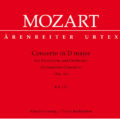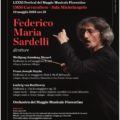Bärenreiter publisher continues it’s rediscovering activity of great masters’ authentic music, in order to remove all the spuroius changes and additiosn – legacy of many decades and centuries of not so accurate editions – that distort the original sense intended by the author; in this case, the reason of so much interest is the new urtext edition of the well-known Piano sonata in b flat major op. 81a “Les Adieux” by the german composer Ludwig van Beethoven.
The most striking element is that the editor is Jonathan Del Mar.

Jonathan Del Mar
Jonathan Del Mar is a titan in the field of beethovenian studies, and he’s often referred to (and rightly) as the most important living scholar about the genius of Bonn. This isn’t the first between Del Mar and Bärenreiter: for the publishing house based in Kassel, Del Mar already edited the critical publication of Beethoven’s nine symphonies, that radically revolutionised the interpretation of Beethoven’s music in the last twenty years. Therefore have the opportunity to take advantage of this authoritative opinion in the study of one of the most enigmatic and mysterious Beethoven’s masterpieces is a precious opportunity to reopen (assuming it wasn’t never closed) the problem of authentic Beethoven, how we’re supposed to understand and perform his music.
The great strenght of the great British musicologist’s reading consists in his scrupulous attention to details, nothing is left to accident; for example, we’d be able to tell this by his acute observations about the use of Punkte and Striche (dots and dashes) in Beethoven’s style. Unlike in Mozart, where – according to musicologist Mario Aschauer – there’s note difference between dots and dashes, we know for certain that this difference exists in Beethoven: a first evidence of this is the punctilious attention in the composition of the Allegretto of Symphony n. 7 in a major op. 92 (following approximately two years this Sonata), where the difference between the two articulations is exceedingly evident:
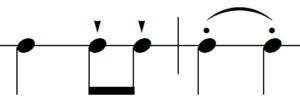
Rhythmic fragment from Allegretto of Symphony no. 7
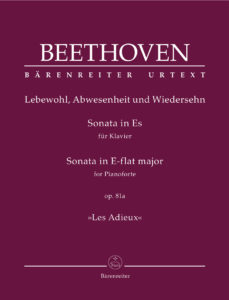 A second evidente is a letter «of 15 August 1825 to karl Holz […] in which Beethoven gives the firm indication that “dots and dashes are not identical”». It may seem a trivial matter, nevertheless this is not only a relevant aspect in a performance, but also musically is a consistent request because this one of those aspects that model the colour of a composition. About this particular case, the op. 81a, in the sources there are some important discrepancies about the use of one or the other articulation in some passages, for example: first mov. bars 32-34, in the primary sources (the original manuscript and the copist’s score revised by Beethoven) we can clearly read the sing of dash, but in both the two first editions (the firs edition published in London by Clementi in January 1811 and the firs german edition published in Leipzig by Breitkopf & Härtel in July 1811) we find printed dot.
A second evidente is a letter «of 15 August 1825 to karl Holz […] in which Beethoven gives the firm indication that “dots and dashes are not identical”». It may seem a trivial matter, nevertheless this is not only a relevant aspect in a performance, but also musically is a consistent request because this one of those aspects that model the colour of a composition. About this particular case, the op. 81a, in the sources there are some important discrepancies about the use of one or the other articulation in some passages, for example: first mov. bars 32-34, in the primary sources (the original manuscript and the copist’s score revised by Beethoven) we can clearly read the sing of dash, but in both the two first editions (the firs edition published in London by Clementi in January 1811 and the firs german edition published in Leipzig by Breitkopf & Härtel in July 1811) we find printed dot.
For a fuller comprehension of Beethoven’s text is fundamental the rich deeping regarding the performance practice, bearing always in mind both the common performance practice of the time and the typical peculiarities required by Beethoven’s music.
Really interesting the study about pedalling: at first glance, without doubst, is surprising how rare are the pedal indications (only thirteen in the whole Sonata) in we bear in mind that in the kind of Beethoven’s klavier, very different from Mozart’s one, the pedal technique was already evolved. We are helped here by the words of one of the most famous Beethoven’s pupils, Carl Czerny: according to him, Beethoven « made frequent use of the pedals, much more frequent than is indicated in his works». From this, we can deduce thant in the points in which the use of pedal is accurately reported, «the use of the pedals was not either self-evident, or simply a matter of taste», expecially since in Beethoven the use of pedals plays an extremely important role, namely not just for play legato the various sound, but for distort them, in order to create characteristics harmonic overlappings or particular “blurs” of the sounds, as in the case of the powerful octaves in the third movement:
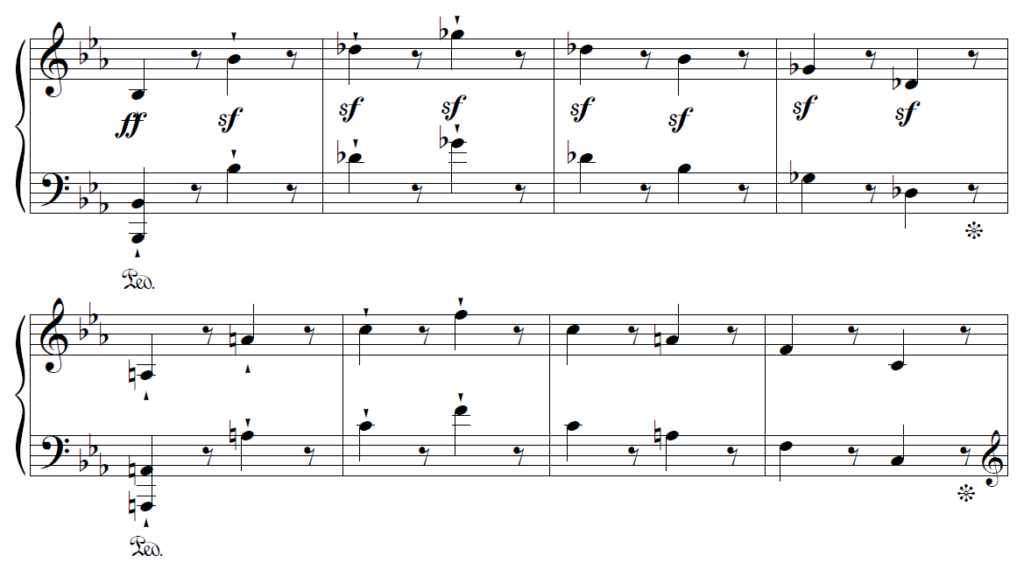
III mov., Das Wiedersehn, bars 37- 44
Respecting the pedal indication written by Beethoven, we obtain an effect not softening the strenght of this marked pattern, but lends an air of and ample range of harmonics that resonate overlapping each other. It must also be said that this effect sounded in a very special way on the klavier at disposal of Beethoven and of his contemporaries, with rich shades that are impossible to obtain from a modern instrument.
This point is vital for a proper understandig of the real problem that the modern pianist must face when is about to study a composition by Ludwing van Beethoven: our pianos are different. It’s not too muc from leap saying that is another instrument, since the piano of the early XIX century had a different range, keys were a lot lighter and the action was quite more brilliant, moreover there were a remarkable heterogeneity between the various registers: in certain regions of the keyboard the sound was lighter, in others darker, in others weaker. For this reason Del Mar couldn’t be more right than this saying that «to perform a keyboard work by Beethoven on a modern piano is to play a transcription of music conceived for a very different type of instrument».
For this reason, the present edition represents a really considerable crux: being philological doesn’t mean to play an 1802 Érard, it means to be clear what the composer wants and consequently to identify the better ways to reach the target. An edition like the one published by Bärenreiter allows to receive the adequate intruments for an aware and historically informed study on the score, both as regards the historical and cultural context that generated it and as redards specific peculiarity of the performance practice of the time.
lfmusica@yahoo.com
- Pisa celebra il “suo” Guglielmo Tell - 4 Marzo 2020
- “Don Giovanni” al Teatro Verdi di Pisa, un succès de scandale - 27 Gennaio 2020
- “Ernani” ritorna al Verdi di Pisa in cappa e spada - 17 Dicembre 2019


